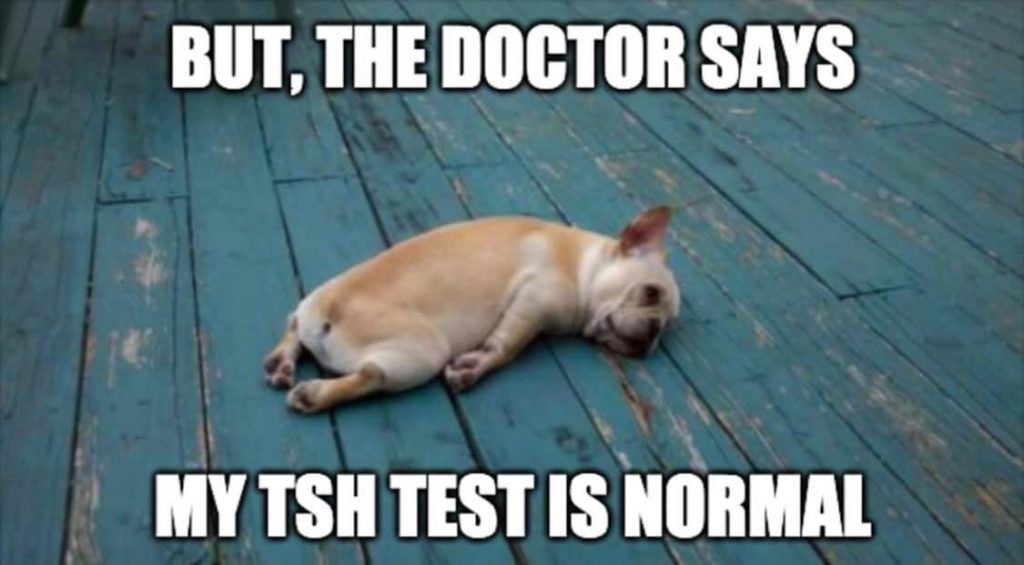The Lab Panel Your Doctor Isn’t Ordering, and Why You Still Feel Crappy
If I had a dollar for every person that came to me and said that their labs were “normal” but they still don’t feel well, I could retire tomorrow (not that I’d want to!). This is especially true when it comes to thyroid labs.
The thyroid is a small butterfly-shaped gland in the neck, and despite its tiny size, it has a huge impact on how we feel. The thyroid is responsible for producing thyroid hormones, which then are supposed to enter the cell and control our metabolism, or the rate at which energy is generated from our food. In other words, the thyroid is responsible for how much energy we do or do not have throughout the entire body. What a huge task!
When thyroid hormone is adequate and our cells are humming away, we feel great! Energized! Happy! And when it’s not enough, we know that, too. Tired, fatigued, dull, disinterested, depressed, unmotivated, constipated, poor digestion, malabsorption, poor immune function, hair loss, brittle hair or nails, constantly feeling cold, infertility, and the list goes on. Ugh.

Ironically, it is often the people that have these clearcut hypothyroid symptoms that show up in our practice, and when asked, have you had your thyroid checked, they respond, “Yes! And the doctor said it was normal!”
Then we ask to see the labs. And we then see one of 2 things:
1. Only TSH was checked, or sometimes TSH plus free T4
2. Several thyroid specific markers were checked, and while the values were in the normal reference range, they were not within the OPTIMAL, functional reference range (read why this matters here)
Let’s unpack this.
The brain tells the thyroid to make more thyroid hormone by increasing TSH. Therefore, TSH is a brain hormone. It’s not responding to how much thyroid hormone the gut, or the liver, or the heart may need. Does it make sense then to only rely on 1 marker to understand what’s going on elsewhere? Additionally, the standard reference range is woefully huge, like, drive-an-SUV-through huge. It goes from 0.5-4.5. Now, research shows, and client and personal experience show, that we tend to feel our best when brain TSH falls between 0.5-1.5. Those with TSH at 2+ may start to feel some of those low thyroid symptoms. But technically they’re “normal.” Just miserable. Lots of people are normal and still miserable.

Looking beyond TSH, we want to look at the actual thyroid hormones themselves. We most commonly check T4 and T3. T4 is a weakly stimulating hormone while T3 is the “let’s kick it into high gear” hormone. Clearly we want enough T3, but we also need enough T4, which converts to T3.
The body is very careful with its control over thyroid hormone. So we look at total, or all of that type of hormone produced, as well as free, or what the body is allowing as available to be used. The body also has another choice point here. It can send T4 to convert to reverse-T3, or rT3. If we think of free T3 as gas peddle, rT3 is the break peddle. It forces the body to slow metabolism. It is shortsighted to not draw all 5 of these markers when trying to understand why low thyroid symptoms exist.
Why thyroid hormones get low
Part of our enjoyment of a functional approach to health is figuring out what the root causes of someone’s symptoms are, and thyroid detective work is no different! Here are some common reasons why thyroid hormone can be low:
1. not enough tyrosine – an amino acid that is a building block of T4/T3 – from insufficient diet, poor digestion, malabsorption
2. not enough selenium and/or iodine – critical minerals for thyroid hormone production – from insufficient diet, poor digestion, malabsorption, or displacement from fluoride, chlorine, and other elements on that periodic table
3. not enough zinc or iron – from insufficient diet, poor digestion, malabsorption
4. elevated rT3 blocking active free T3 – from stress, gut microbial imbalances, heavy metals, viral load, toxicity
5. destruction by thyroid antibodies
Thyroid antibodies are a rabbit hole in and of themselves. But I’ll say simply that the presence of anti-thyroid peroxidase (anti-TPO) and anti-thyroglobulin (anti-Tg) antibodies indicate the body is actively destroying the ability to make T4. No T4, no T3. There are many reasons for this but common ones include confusion between gluten and the body’s own tissue, chronic simmering infections like Epstein-Barr or H pylori, or toxicity. So you can see why both antibody tests are also important to draw, but rarely are.
How a functional approach to thyroid health is different
1. We’re looking at a full thyroid panel, not just 2 markers that aren’t reflective of the full possibilities of what’s going on
2. We’re looking at functional (optimal) ranges. Not conventional ranges (which have their own purpose)
3. We’re listening to the symptoms and investigating the origins of the symptoms – usually somewhere else in the body than the thyroid!

In this way we help people identify their specific issues and help them feel better.
If you’re curious whether your thyroid is to blame for your symptoms, schedule a complementary strategy session to discuss how thoroughly checking your thyroid may help you get back to enjoying your life!
References
Labcorp. (2021). Thyroid panel. Retrieved from https://www.labcorp.com/help/patient-test-info/thyroid-panel
Pizzorno, J.E. & Murray, M.T. (2012). Textbook of natural medicine (4th ed.). St. Louis, MO: Churchill Livingston.
School of Applied Functional Medicine. (2021). Thyroid myths and truths. Retrieved from schoolafm.com portal.
Stop The Thyroid Madness. (2021). Optimal lab values. Retrieved from https://stopthethyroidmadness.com/lab-values/
